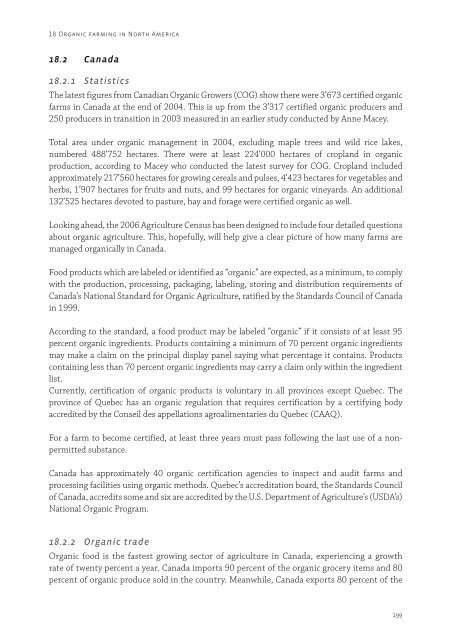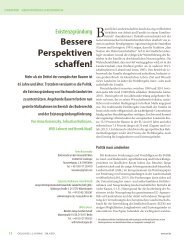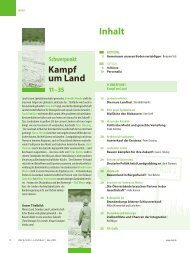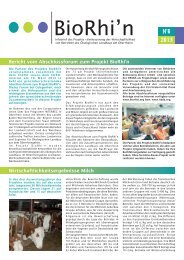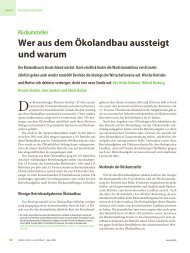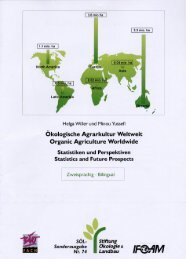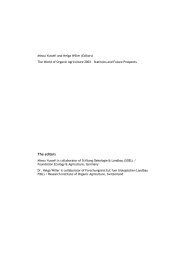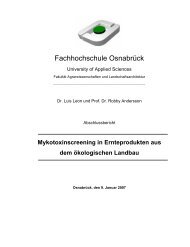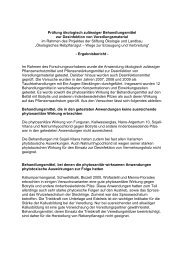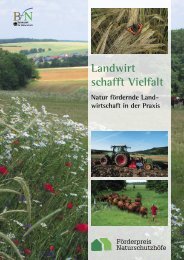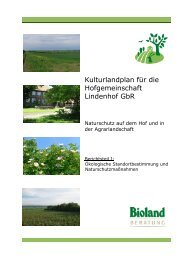the world of organic agriculture - Organic Eprints
the world of organic agriculture - Organic Eprints
the world of organic agriculture - Organic Eprints
Create successful ePaper yourself
Turn your PDF publications into a flip-book with our unique Google optimized e-Paper software.
18 <strong>Organic</strong> farming in North America<br />
18.2 Canada<br />
18.2.1 Statistics<br />
The latest figures from Canadian <strong>Organic</strong> Growers (COG) show <strong>the</strong>re were 3’673 certified <strong>organic</strong><br />
farms in Canada at <strong>the</strong> end <strong>of</strong> 2004. This is up from <strong>the</strong> 3’317 certified <strong>organic</strong> producers and<br />
250 producers in transition in 2003 measured in an earlier study conducted by Anne Macey.<br />
Total area under <strong>organic</strong> management in 2004, excluding maple trees and wild rice lakes,<br />
numbered 488’752 hectares. There were at least 224’000 hectares <strong>of</strong> cropland in <strong>organic</strong><br />
production, according to Macey who conducted <strong>the</strong> latest survey for COG. Cropland included<br />
approximately 217’560 hectares for growing cereals and pulses, 4’423 hectares for vegetables and<br />
herbs, 1’907 hectares for fruits and nuts, and 99 hectares for <strong>organic</strong> vineyards. An additional<br />
132’525 hectares devoted to pasture, hay and forage were certified <strong>organic</strong> as well.<br />
Looking ahead, <strong>the</strong> 2006 Agriculture Census has been designed to include four detailed questions<br />
about <strong>organic</strong> <strong>agriculture</strong>. This, hopefully, will help give a clear picture <strong>of</strong> how many farms are<br />
managed <strong>organic</strong>ally in Canada.<br />
Food products which are labeled or identified as “<strong>organic</strong>” are expected, as a minimum, to comply<br />
with <strong>the</strong> production, processing, packaging, labeling, storing and distribution requirements <strong>of</strong><br />
Canada’s National Standard for <strong>Organic</strong> Agriculture, ratified by <strong>the</strong> Standards Council <strong>of</strong> Canada<br />
in 1999.<br />
According to <strong>the</strong> standard, a food product may be labeled “<strong>organic</strong>” if it consists <strong>of</strong> at least 95<br />
percent <strong>organic</strong> ingredients. Products containing a minimum <strong>of</strong> 70 percent <strong>organic</strong> ingredients<br />
may make a claim on <strong>the</strong> principal display panel saying what percentage it contains. Products<br />
containing less than 70 percent <strong>organic</strong> ingredients may carry a claim only within <strong>the</strong> ingredient<br />
list.<br />
Currently, certification <strong>of</strong> <strong>organic</strong> products is voluntary in all provinces except Quebec. The<br />
province <strong>of</strong> Quebec has an <strong>organic</strong> regulation that requires certification by a certifying body<br />
accredited by <strong>the</strong> Conseil des appellations agroalimentaries du Quebec (CAAQ).<br />
For a farm to become certified, at least three years must pass following <strong>the</strong> last use <strong>of</strong> a nonpermitted<br />
substance.<br />
Canada has approximately 40 <strong>organic</strong> certification agencies to inspect and audit farms and<br />
processing facilities using <strong>organic</strong> methods. Quebec’s accreditation board, <strong>the</strong> Standards Council<br />
<strong>of</strong> Canada, accredits some and six are accredited by <strong>the</strong> U.S. Department <strong>of</strong> Agriculture’s (USDA’s)<br />
National <strong>Organic</strong> Program.<br />
18.2.2 <strong>Organic</strong> trade<br />
<strong>Organic</strong> food is <strong>the</strong> fastest growing sector <strong>of</strong> <strong>agriculture</strong> in Canada, experiencing a growth<br />
rate <strong>of</strong> twenty percent a year. Canada imports 90 percent <strong>of</strong> <strong>the</strong> <strong>organic</strong> grocery items and 80<br />
percent <strong>of</strong> <strong>organic</strong> produce sold in <strong>the</strong> country. Meanwhile, Canada exports 80 percent <strong>of</strong> <strong>the</strong><br />
199


